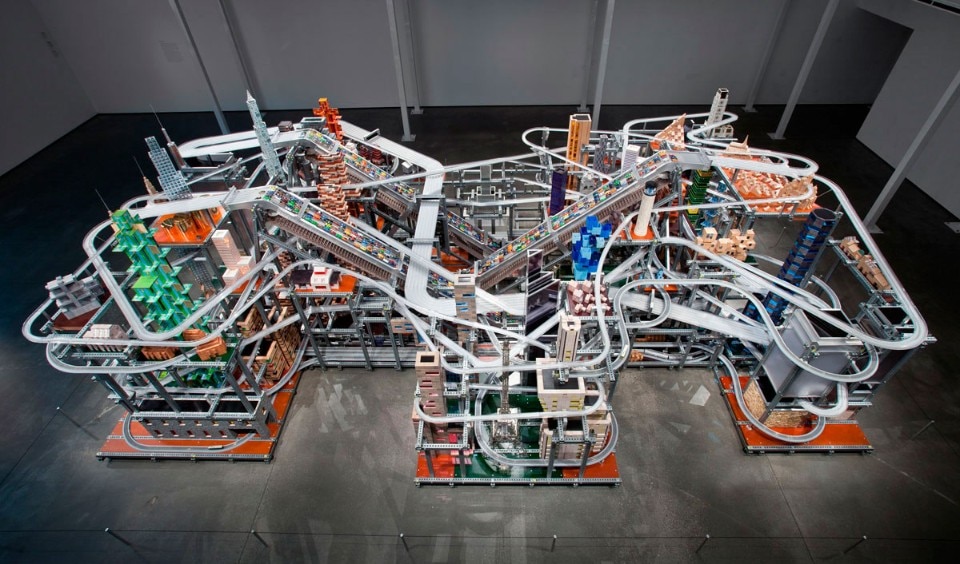Metropolis II represents the frenzy of a modern city through its traffic. Eighteen roadways, including a six-lane highway and a railway, with a total of 100,000 scaled vehicles, including 1,100 custom-built cars, eight looping trains, and five trolleybuses, racing at 240 miles per hour on a tangle of tracks.
Created by artist Chris Burden in 2010, the enormous kinetic sculpture has been on loan to the Los Angeles County Museum of Art (LACMA) for several years now. Since its arrival, it has quickly become one of the museum's main attractions, recognized by the public as a symbolic work that captures the essence of modern cities, and in particular, Los Angeles.
The noise, the continuous flow of trains, and the fast-moving toy cars create in the viewer the stress of living in a dynamic, active, and frenetic 21st-century city.
Chris Burden
The piece includes over 200 buildings, including two made with LEGO bricks, two with Lincoln Logs, and one made of cards. But the most commonly used building materials are HABA blocks, which the artist has stained, painted, and modified to create segmented and disjointed architectures, evoking the idea of a multicultural community.
Over time, LACMA has needed to train four specialized operators to ensure the sculpture's operation. Adrienne Sacks is one of the technicians who every day sits in the center of the track, activates it, and monitors its performance to prevent any malfunctions:
As one of the four kinetic sculpture technicians at LACMA, my job is to ensure that the largest kinetic artwork we have on display, Chris Burden's Metropolis II, functions exactly as the artist intended for the public.
Adrienne Sacks
The cars are lifted 10 feet by a conveyor ramp using a magnet positioned in the track’s framework and then released at the top to descend along 75 feet of track. After a short wait at the base of the ramp, they are pushed by the next car to be returned to the top. Each car operates for over 500 hours, covering approximately 5,300 miles—the equivalent of a real car traveling about 300,000 miles—before undergoing a "tire service" review.

A complex circuit ensures continuous motion, but not without glitches. Just like the tangled network of highways in Los Angeles, Metropolis II is inevitably affected by traffic jams.
With its 71 kilometers in length and 47 kilometers in width, Los Angeles has allocated 70% of its urban space to roads and parking. Yet, city traffic remains among the worst in the world, highlighting how adding new roads does not necessarily solve the problem but can often make it worse. The so-called "Braess Paradox" explains how expanding the road network can actually slow down overall traffic flow, creating bottlenecks and worsening congestion. It’s a real case of the tail wagging the dog, considering that in Los Angeles County, in 2023, approximately 9.72 million people were matched by 6.9 million registered vehicles. This figure underscores the city’s heavy reliance on cars, due both to its urban sprawl and limited public transportation options.
Traffic in Los Angeles is so congested that each resident loses about $6,000 a year idling in traffic — at a total cost of $23 billion, exceeding the entire cost of traffic congestion in Great Britain.
The Economist, 2014
The loan of Metropolis II is about to expire, but it is important that the artwork remains at LACMA. Not only will this allow it to continue receiving the necessary care from a highly specialized team, but it will also serve as a reminder of the urgency for more sustainable cities.
Opening image: Chris Burden, Metropolis II, 2010.
Courtesy of the Nicolas Berggruen Charitable Foundation and Los Angeles County Museum of Art (LACMA). © Chris Burden.
Video: Metropolis II (The Movie). Directed by Henry Joost and Ariel Schulman. Edited by Max Joseph.









